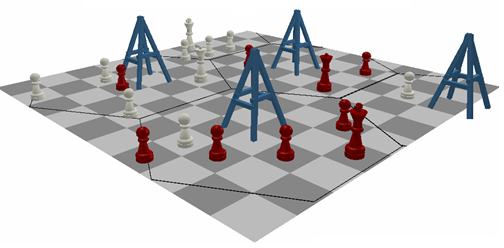
 |
Analysis and Design of Cognitive Radio Networks Using Game Theory |
||
While even minimally cognitive radios hold great promise, there is some concern that cognitive radios may negatively impact network performance. While how a cognitive radio can negatively impact network performance may not be immediately apparent from cognition cycle shown in Figure 1.1, a more realistic diagram of the processes of a cognitive radio in a network is shown in Figure 1.3 where cognitive radios react to both “dumb” and cognitive radios. Specifically, many cognitive radios will be reacting to an outside world whose state is jointly determined by the adaptations of several cognitive radios, making any network of two or more cognitive radios an interactive decision process.
figure 1-3: The interactive cognitive radio model |
While we intuitively understand the reaction of a cognitive radio to a collection of
“dumb” radios, the interaction of a collection or cognitive radios is less clear as each
cognitive radio waveform adaptation changes the state of the outside world for all the
other radios. The actions of a collection of cognitive radios would then appear as a
recursive interactive decision process as adaptation spawns adaptation after adaptation,
perhaps infinitely as implied by Figure 1.16. Such an infinite process of adaptations
makes performance guarantees difficult to make and networks nearly impossible to plan
in a traditional sense. Further, while some authors have proposed having the receiver
dynamically determine the adaptations of the transmitter; it seems more reasonable that
any adaptations will be performed at least with the knowledge of the receiver, if not
actually directed by the receiver. So an infinite recursion of adaptations may imply poor
utilization of spectrum as bandwidth is consumed to signal these adaptations.
figure 1-4: A network of adaptive radios that has fallen into an infinite adaptation
recursion. |
Even when these adaptations do not continue infinitely, the final state of the network
might be quite undesirable. For instance, consider a single cluster DS-SS network with a
centralized receiver where all nodes other than the centralized receiver are adjusting their
transmitted power levels in an attempt to maximize their signal-to-interference-plus-noise
ratio (SINR) as measured at the receiver. The initial state in terms of transmit power
levels (blue) and SINR (green) for this network are shown in Figure 1.17. Following this
implied adaptation scheme, the final state for this network is shown in Figure 1.6 where
all terminals are transmitting at their maximum power levels. Clearly this is an undesirable
outcome as
(1) capacity is greatly diminished due to near-far problems (unless the nodes are all at the same radius from the receiver) and counter to a goal of MANET operation,
(2) the resulting SINRs are unfairly distributed (the closest node will have a far superior SINR to the furthest node), and
(3) battery life would be greatly shortened.
figure 1-5: Initial network state. |
figure 1-6: Initial network state. |
Abstracting the problem of interactive cognitive radios, consider a network of three radios where repeated adaptations define out paths in the action space (the combined set of all possible choices of waveforms by the three cognitive radios). Sometimes these paths terminate in a stable point; under different conditions the paths may enter an infinite loop. There may also be points in the action space which are fixed points of the decision update rule but are unstable as any small perturbation in initial conditions drive the network away from the point. Each of these concepts is illustrated in the example interaction diagram shown in Figure 1.19 where paths are shown by the arrows and fixed points are labeled as “NE” in reference to “Nash equilibrium”.
figure 1-7: A network of adaptive radios that has fallen into an infinite adaptation
recursion. |
This conceptual interaction diagram illustrates the four different analysis questions that
we would like to answer when considering a network of interactive cognitive radios.
• What is the expected behavior of the network?
• Does this behavior yield desirable performance?
• What conditions must be satisfied to ensure that adaptations converge to this
behavior?
• Is the network stable?
To answer these questions, several researchers [Neel_06a] [MacKenzie_01] have
proposed the use of game theory to analyze the interactions of autonomous adapting
wireless devices.
 |